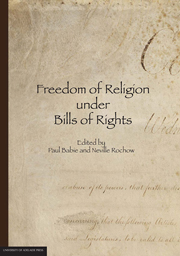Book contents
- Frontmatter
- Contents
- Acknowledgments
- List of Contributors
- Foreword by The Hon Sir Anthony Mason AC KBE: Human Rights and Courts
- INTRODUCTION
- SETTING THE SCENE
- CONTEMPORARY FREEDOM OF RELIGION ISSUES
- COMPARATIVE EXPERIENCE WITH FREEDOM OF RELIGION
- 9 Political Culture and Freedom of Conscience: A Case Study of Austria
- 10 The Sky is Falling if Judges Decide Religious Controversies! – Or is it? The German Experience of Religious Freedom Under a Bill of Rights
- 11 Religious Freedom in a Secular Society: The Case of the Islamic Headscarf in France
- 12 Religious Freedom in the UK after the Human Rights Act 1998
- 13 Judicial Interpretation, Neutrality and the US Bill of Rights
- 14 Protecting Religious Freedom: Two Counterintuitive Dialectics in US Free Exercise Jurisprudence
- 15 Walking the Tightrope: The Struggle of Canadian Courts to Define Freedom of Religion under the Canadian Charter of Rights and Freedoms
- 16 Quo Vadis The Free Exercise of Religion? The Diminishment of Student Religious Expression in US Public Schools
- 17 Freedom from Discrimination on the Basis of Religion
- 18 Ruminations from the Shaky Isles on Religious Freedom in the Bill of Rights Era
- 19 Indigenous Peoples and Bills of Rights
- TABLE OF LEGISLATION AND INTERNATIONAL INSTRUMENTS
- INDEX
15 - Walking the Tightrope: The Struggle of Canadian Courts to Define Freedom of Religion under the Canadian Charter of Rights and Freedoms
from COMPARATIVE EXPERIENCE WITH FREEDOM OF RELIGION
Published online by Cambridge University Press: 05 June 2013
- Frontmatter
- Contents
- Acknowledgments
- List of Contributors
- Foreword by The Hon Sir Anthony Mason AC KBE: Human Rights and Courts
- INTRODUCTION
- SETTING THE SCENE
- CONTEMPORARY FREEDOM OF RELIGION ISSUES
- COMPARATIVE EXPERIENCE WITH FREEDOM OF RELIGION
- 9 Political Culture and Freedom of Conscience: A Case Study of Austria
- 10 The Sky is Falling if Judges Decide Religious Controversies! – Or is it? The German Experience of Religious Freedom Under a Bill of Rights
- 11 Religious Freedom in a Secular Society: The Case of the Islamic Headscarf in France
- 12 Religious Freedom in the UK after the Human Rights Act 1998
- 13 Judicial Interpretation, Neutrality and the US Bill of Rights
- 14 Protecting Religious Freedom: Two Counterintuitive Dialectics in US Free Exercise Jurisprudence
- 15 Walking the Tightrope: The Struggle of Canadian Courts to Define Freedom of Religion under the Canadian Charter of Rights and Freedoms
- 16 Quo Vadis The Free Exercise of Religion? The Diminishment of Student Religious Expression in US Public Schools
- 17 Freedom from Discrimination on the Basis of Religion
- 18 Ruminations from the Shaky Isles on Religious Freedom in the Bill of Rights Era
- 19 Indigenous Peoples and Bills of Rights
- TABLE OF LEGISLATION AND INTERNATIONAL INSTRUMENTS
- INDEX
Summary
Render to Caesar the things that are Caesar's and to God the things that are God's.
How should the laws of the state be balanced against the precepts of religion? In Canada, this age-old question has received renewed attention since the 1982 adoption of the Canadian Charter of Rights and Freedoms, which constitutionally guarantees freedom of ‘conscience and religion’ to every person in the country. Like most modern Western democracies, Canada does not have a state religion and the Canadian polity is comprised of individuals holding a wide range of religious views. This means that, in order to comply with the Charter's guarantee of religious freedom, law-makers must consider the impact of legislation on a wide range of religious beliefs and practices. To ensure that legislators take proper account of religious freedom, the Canadian constitution empowers the courts to nullify any law that unjustifiably infringes upon Charter rights. This casts Canadian courts as the arbiters of any conflict between positive law and religious freedom. In order to fulfil this role, the courts have been forced to conceptualize and articulate a meaningful definition of freedom of religion and to set parameters on the constitutional protection of freedom of religion so as to accommodate other competing, but legitimate, social concerns.
In this chapter, my primary intention is to explain how ‘freedom of religion’ operates as a constitutional right under the Charter and to outline the scope of this right as it has been defined thus far by Canadian case law. By way of background, I begin with a brief discussion of the role played by ‘freedom of religion’ in Canadian law prior to the adoption of the Charter.
- Type
- Chapter
- Information
- Freedom of Religion under Bills of Rights , pp. 321 - 348Publisher: The University of Adelaide PressPrint publication year: 2012



